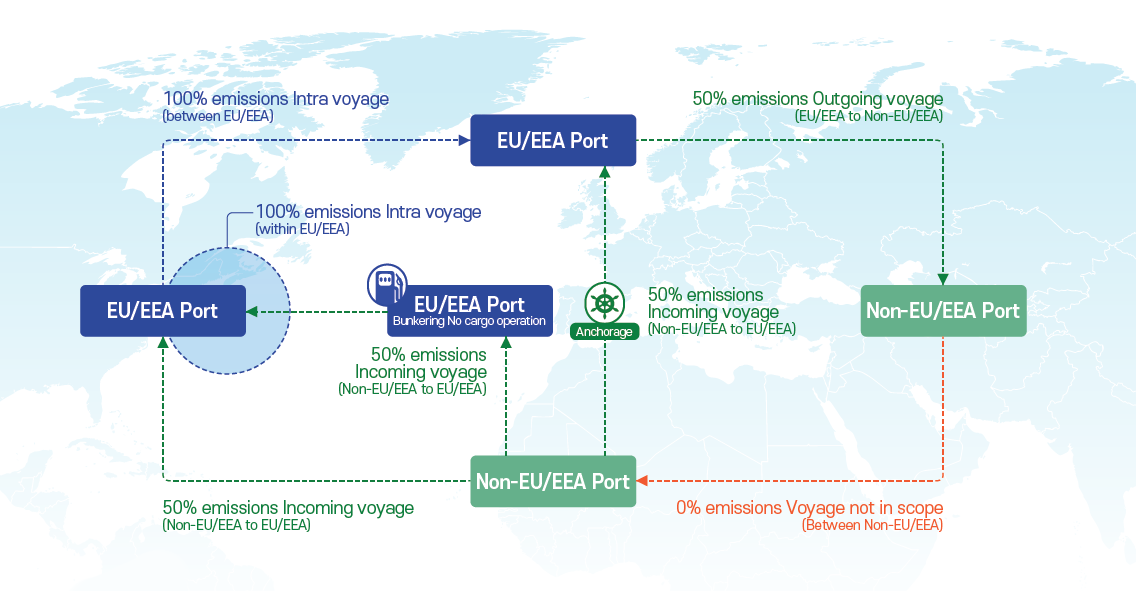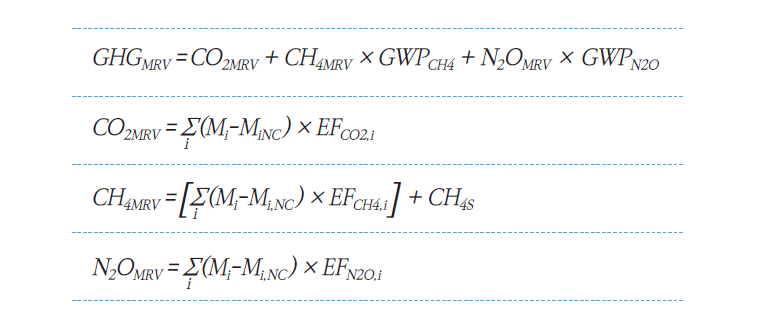Regulatory Updates
KR Decarbonization Magazine
VOL.06 | Spring 2024
| EU Regulatory Trends |
EU ETS Requirements and Securing Allowances

Independently from the IMO global initiative, the European Union (EU) announced the Fit for 55 package in July 2021, following the proposal of the European Green Deal.
The Fit for 55 package comprises several legislative proposals aimed at various industrial sectors to meet the med-term reduction goal outlined in the European Climate Act (aiming for at least a 55% reduction by 2030 compared to 1990). It directly pertains to international shipping. Related issues include the expanded application of the European Union Emissions Trading System (ETS) to marine transportation emissions from 2024, and the regulation to promote the use of renewable and low-carbon fuels in maritime transportation (FuelEU Maritime), which will take effect from 2025.
ETS is a system that allows the rights to emit greenhouse gases to be bought and sold as emission permits. EU ETS has been applied to EU land-based industries since 2005 and was expanded to the aviation sector operating in the EU from 2012. As part of the EU ETS revision proposals within the Fit for 55 package it will now cover the emissions of the shipping sector from 2024. EU ETS in the shipping sector applies to all ships above a gross tonnage of 5,000 operating in the European Economic Area (EEA), regardless of the ship’s registered flag, and requires the monitoring, reporting and verification of greenhouse gas emissions. Emission allowances corresponding to the reported emissions according to EU MRV must be surrendered to the EU Administering Authority. The entity responsible for implementing EU MRV and EU ETS requirements (such as emission monitoring and reporting, emission credit submission, etc.) is the shipping company.

1. Scope of GHG Emissions from EEA Voyages
In the EU MRV and EU ETS regulations, a voyage means any movement of a ship that originates from or terminates in a port of call. Port of call means the port where a ship stops to load or unload cargo or to embark or disembark passengers. This means stops for the sole purpose of refueling, obtaining supplies, etc., and the stops of containerships in a neighbouring container transshipment port1) listed in the implementing act adopted pursuant to Article 3ga (2) of the EU ETS Directive are excluded.
While EU MRV calculates and reports greenhouse gas emissions for all voyages related to the European Economic Area (EEA), EU ETS applies different greenhouse gas emissions calculation rates depending on the type of EEA-related voyage as follows:
1) EAST PORT SAID in Egypt and TANGER MED in Morocco (Implementing Regulation(EU) 2023/2297, As of 26 October 2023)
▶ 50% of emissions generated from voyages departing from a port of call under the jurisdiction of the EEA and arriving at a port of call under the jurisdiction of a third country.
▶ 50% of emissions generated from voyages departing from a port of call under the jurisdiction of a third country and arriving at a port of call under the jurisdiction of the EEA.
▶ 100% of emissions generated from voyages departing from ports of call under EEA jurisdiction and arriving at ports of call under EEA jurisdiction.
▶ 100% of emissions from ships within a port of call under EEA jurisdiction.

2. Type of GHG Included in EU ETS
EU MRV requires reporting of carbon dioxide (CO₂), methane (CH₄) and nitrous oxide (N₂O) emissions starting in 2024.
The EU ETS includes only carbon dioxide (CO₂) emissions from 2024, but from 2026 carbon dioxide (CO₂), methane (CH₄), and nitrous oxide (N₂O) emissions will be included.
| 2024 | 2025 | 2026 | |
|---|---|---|---|
| Carbon Dioxide(CO₂) | MRV+ETS | ||
| Methane(CH₄) | MRV | MRV+ETS | |
| Nitrous Oxide(N₂O) | MRV | MRV+ETS | |
3. Phase-in of requirements for surrendering allowances
EU ETS requires the surrender of emission allowances equivalent to the emissions for the reporting period (y), which are reported by March of the following period (y+1) under EU MRV. Emission allowances shall be surrendered to EEA Member States by September of the following period (y+1) according to the phase-in rates applicable for the reporting period (y):
▶ 40% of CO₂ emissions in 2024 (surrendered by September 2025)
▶ 70% of CO₂ emissions in 2025 (surrendered by September 2026)
▶ 100% of CO₂, CH₄ and N₂O emissions from 2026 (surrendered by September each year from 2027)
4. Shipping Company’s Responsibilities
‘The Shipping Company’ is responsible for the implementation of EU MRV (emissions monitoring, reporting and verification, etc.) and EU ETS (surrender of emissions allowance, etc.).
The ‘Shipping Company’ means a shipowner or a manager or charterer delegated by the shipowner with responsibility for the operation of a vessel, where such responsibility is in accordance with the International Safety Management Code (ISM Code) set out in Annex I of Regulation (EC) No 336/2006.
The ‘Shipowner’ refers to the registered owner identified on the ship's Certificate of Registry and having an IMO Unique Company and Registered Owner Identification Number.
The European Commission announced the results of the EU Administering Authority allocation to Shipping Companies on January31, 2024 and will update the allocation list every two years.
Shipping Companies must submit information about the vessel(s) for which they are responsible under Implementing Regulation (EU) 2023/2599 to the EU Administering Authority.
If the Shipping Company is designated as an ISM Company, the ISM Company must submit documents proving that responsibility for EU MRV and ETS obligations has been delegated by the shipowner to the EU Administering Authority and verifier. If there is no supporting documentation, the Shipowner is considered to be subject to MRV and ETS obligations.
All Shipping Companies are now obligated to open a maritime operator holding account (“MOHA”) used to deliver and trade emission allowances within 40 days2), counting from the publishing date of the list. For Shipping Companies not included in the list, the deadline is 65 working days of the first port of call falling within the scope of the EU ETS Directive. A Shipping Company must submit allowances from its MOHA. Contact information for each EU Administering Authority to apply for MOHA opening can be found at the following link3).
2) Within 65 working days after first EEA port of call falling within ETS scope
3) https://climate.ec.europa.eu/eu-action/eu-emissions-trading-system-eu-ets/union-registry_en#links

5. Transfer of the costs of the EU ETS
If an entity other than the Shipping Company is responsible for the purchase of fuel or the operation of the ship, the Shipping Company may be reimbursed by that entity for the costs incurred in submitting emissions credits.
Operation of a ship means determining the route and speed of cargo or a vessel.
EU Member States must take national action to ensure that Shipping Companies receive reimbursement and provide judicial access to enforce that right.
The Baltic and International Maritime Council (BIMCO) has proposed provisions4) containing standard terms and conditions to clarify the costs and responsibilities associated with the ETS.
▶ Emission Scheme Freight Clause for Voyage Charter Parties 2023
▶ Emission Scheme Surcharge Clause for Voyage Charter Parties 2023
▶ Emission Scheme Transfer of Allowances Clause for Voyage Charter Parties 2023
▶ SSHIPMAN Emission Trading Scheme Allowances Clause 2023

6. Ways to Obtain emission allowances
EUA (European Union Allowance) is the official name for the emissions rights traded in the EU ETS. One EUA grants the holder the right to emit one tonne of greenhouse gases (tCO2eq).
In order for a Shipping Company to purchase and trade EUA, it must open an account (MOHA) at the Union Registry. The methods to obtain EUA are as follows:
▶ Auction
Purchase by participating in an auction in the primary market through the European Energy Exchange (EEX), the EU ETS auction platform.
▶ Trading
EUA spot or future trading in secondary markets through emissions exchanges or over-the-counter markets.
7. Calculation of GHG emissions
A ship’s greenhouse gas emissions must be calculated using the following formula in accordance with Delegated Regulation (EU) 2023/2776.

where GHGMRV is greenhouse emissions (tCO2eq), CO2MRV, CH4MRV and N₂OMRV are total aggregated each GHG emitted (tGHG), GWPCH4 and GWPN2O are the global warming potential of each GHG over 100 years as referred to in the Annex to Delegated Regulation (EU) 2020/1044, i is the fuels used on board the ship in the reporting period, j is emission sources on board the ship including the main engines, auxiliary engines, gas turbines, boilers and inert gas generators, EFCO2,i, EFCH4,i and EFN2O,i are tank-to-wake emission factors by fuel i.
Mi,NC which is total mass of fuel i not combusted but released into the atmosphere and CH₄ which is the amount of CH4s non combusted released into the atmosphere are calculated with the following formula.


